
Charles XV also Carl ; Swedish: Karl XV and Norwegian: Karl IV was King of Sweden and Norway, there often referred to accurately as Charles IV, from 1859 until his death in 1872. Though known as King Charles XV in Sweden, he was actually the ninth Swedish king by that name, as his predecessor Charles IX had adopted a numeral according to a fictitious history of Sweden. Charles XV was the third Swedish monarch from the House of Bernadotte and the first one to be born in Sweden.

Margrethe II is Queen of Denmark and commander-in-chief of the Danish Defence.

Gustaf V was King of Sweden from 1907 until his death in 1950. He was the eldest son of King Oscar II of Sweden and Sophia of Nassau, a half-sister of Adolphe, Grand Duke of Luxembourg. Reigning from the death of his father, Oscar II, in 1907 to his own death 42 years later, he holds the record of being the oldest monarch of Sweden and the third-longest rule, after Magnus IV and Carl XVI Gustaf. He was also the last Swedish monarch to exercise his royal prerogatives, which largely died with him, although they were formally abolished only with the remaking of the Swedish constitution in 1974. He was the first Swedish king since the High Middle Ages not to have a coronation and so never wore the king's crown, a practice that has continued ever since.

Carl XVI Gustaf is King of Sweden. He ascended the throne on the death of his grandfather, King Gustaf VI Adolf, on 15 September 1973.
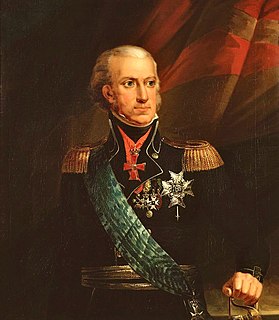
Charles XIII, or Carl XIII, was King of Sweden from 1809 and King of Norway from 1814 to his death. He was the second son of King Adolf Frederick of Sweden and Louisa Ulrika of Prussia, sister of Frederick the Great.

Frederick IX was King of Denmark from 1947 to 1972.
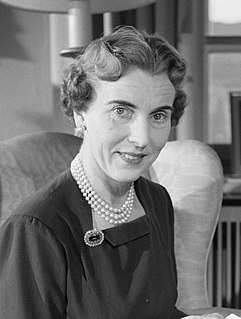
Ingrid of Sweden was Queen of Denmark from 1947 until 1972 as the wife of King Frederick IX.
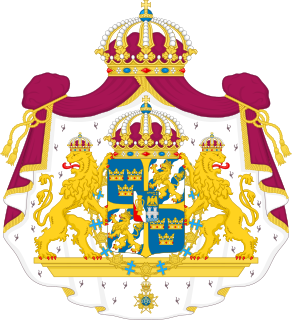
The monarchy of Sweden concerns the monarchical head of state of Sweden, which is a constitutional and hereditary monarchy with a parliamentary system. There have been kings in what now is the Kingdom of Sweden since time immemorial. Originally an elective monarchy, it became an hereditary monarchy in the 16th century during the reign of Gustav Vasa, though virtually all monarchs before that belonged to a limited and small number of families which are considered to be the royal dynasties of Sweden.

Princess Ingeborg of Denmark, was a Princess of Sweden by marriage to Prince Carl, Duke of Västergötland. She was the daughter of Frederick VIII of Denmark, and the maternal grandmother of Harald V of Norway, Baudouin and Albert II of Belgium, the matrilineal great grandmother of Henri, Grand Duke of Luxembourg, the paternal grand-aunt of Margrethe II of Denmark, and the great-grandaunt of Carl XVI Gustaf of Sweden.

Prince Oscar Carl August Bernadotte, Count of Wisborg was a Swedish religious activist, the second son of King Oscar II of Sweden and his consort, Sofia of Nassau. Born as a Prince of Sweden and Norway, he was known as Prince Oscar, Duke of Gotland. However, by marrying contrary to Swedish constitutional requirements, he lost those titles, becoming instead Luxembourgish nobility as Prince Bernadotte and Count of Wisborg.

Prince Bertil, Duke of Halland, was a member of the Swedish royal family. He was the third son of King Gustaf VI Adolf and his first wife, Princess Margaret of Connaught, as well as the uncle of King Carl XVI Gustaf of Sweden, Queen Margrethe II of Denmark and Queen Anne-Marie of Greece. From 1973 to 1979 he was heir presumptive to his nephew King Carl XVI Gustaf and the Swedish throne.

General admiral or Admiral general was a Danish, Dutch, German, Russian, Portuguese, Spanish and Swedish naval rank. Its historic origin is a title high military or naval dignitaries of early modern Europe sometimes held, for example the (nominal) commander-in-chief of the Dutch Republic's navy.
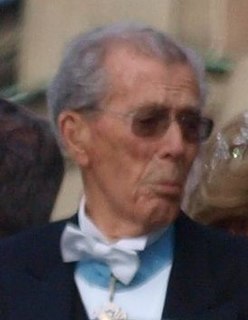
Carl Johan Arthur, Prince Bernadotte, Count of Wisborg, was the fourth son and fifth and youngest child of King Gustaf VI Adolf of Sweden and his first wife Princess Margaret of Connaught.

The Royal Order of the Seraphim is a Swedish order of chivalry created by King Frederick I on 23 February 1748, together with the Order of the Sword and the Order of the Polar Star. The order has only one class with the dignity of Knight, and is the foremost order of Sweden.
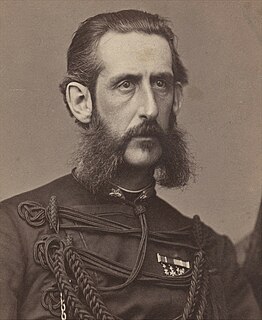
Prince Nikolaus August of Sweden and Norway, Duke of Dalarna was the youngest of the five children of King Oscar I of Sweden and Josephine of Leuchtenberg.
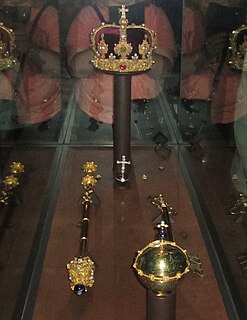
Sweden's regalia are kept deep in the vaults of the Royal Treasury, underneath the Royal Palace in Stockholm, in a museum that is open to the public. The crowns and coronets have not been worn by Swedish royalty since 1907, but they are still displayed at weddings, christenings and funerals.

Olof Rudolf Cederström was a Swedish naval commander. Cederström enlisted in the Swedish admiralty in 1779 and as captain, he conducted a raid against Rogervik. He distinguished himself in 1790 at the naval Battle of Reval and the Battle of Viborg Bay. During the following years he led ships against privateers in the North Sea. He was sent in 1801 to fight alongside the United States Navy in the Mediterranean during the First Barbary War. In 1808 his ships were sent to blockade Gotland in order to repel a Russian invasion. His last military action was against Denmark and France in 1813, when he helped Swedish forces capture Vorpommern. In 1815, he was appointed a minister but returned to the navy in 1818. He finally resigned in 1828.
HMS Ulla Fersen was a frigate of the Swedish Royal Navy, designed by Frederik H. Chapman, and launched in 1789. She served during the Russo-Swedish War (1788-1790), most notably at the Battle of Reval. British vessels twice detained her, once in 1798 and again in 1801, with the first event resulting in a major court case bearing on the meaning of neutrality. She was completely rebuilt in 1802, and lost in a storm in 1807.

Events from the year 1764 in Sweden
Baron Hans Otto Carl Ramel was a Swedish landlord, Hovjägmästare, Master of the Horse and member of parliament.



















